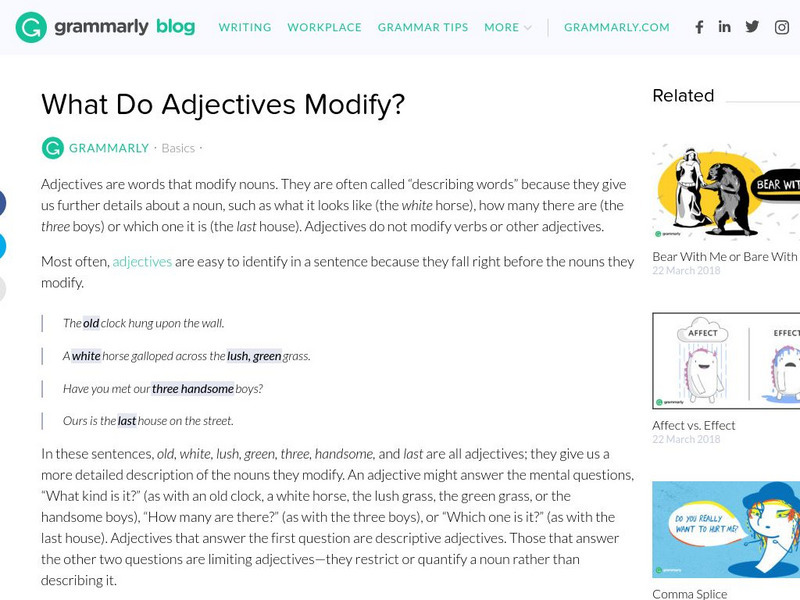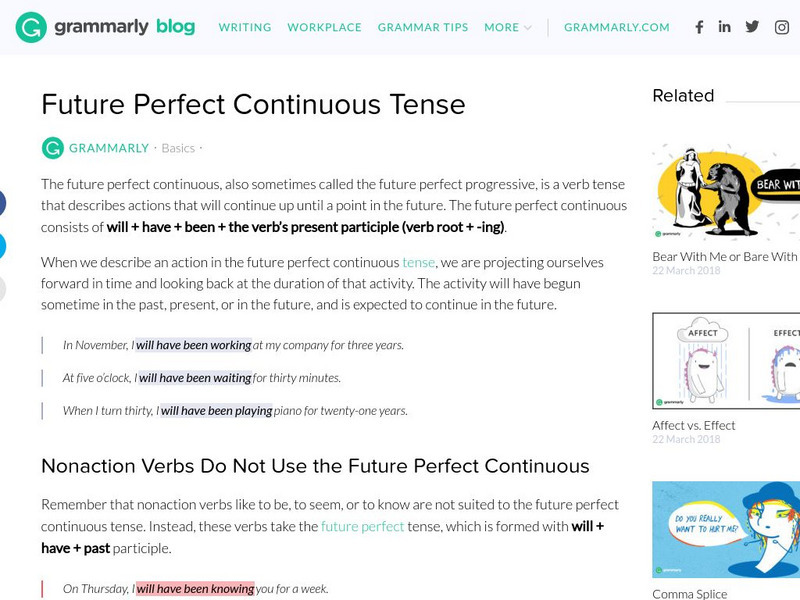Grammarly
Grammarly Blog: Such as Comma
This Grammarly Handbook resource provides information about comma rules related to the phrase such as in a sentence. Examples of such as in non-restrictive clauses are included.
Grammarly
Grammarly Blog: Ellipsis
This page focuses on the ellipsis including what it is, what it means, how to use it, and examples of its use.
Grammarly
Grammarly Blog: Hyphen in Compound Numbers
Rules and examples for using a hyphen when writing compound numbers. L.11-12.2a Hyphens
Grammarly
Grammarly Blog: Consistent Point of View
This Grammarly Handbook resource reminds students how to write with a consistent point of view. Examples are provided to demonstrate how to fix a sentence that contains an inconsistent point of view.
Grammarly
Grammarly Blog: Oxford Comma
Rules and examples for using a comma before the conjunction in a list.
Grammarly
Grammarly Blog: What Do Adjectives Modify?
This blog article explains that adjectives modify nouns and provides examples. It also discusses predicate adjectives.
Grammarly
Grammarly Blog: Verb Tense Consistency: Grammar Rules
This page focuses on the need for verb tense consistency on a clause level. It is important to maintain the same verb tense in a clause; if the time changes, use a second sentence.
Grammarly
Grammarly Blog: Pronoun Case
An explanation with examples of subjective, objective, and possessive case pronouns.
Grammarly
Grammarly Blog: Future Perfect Continuous (Progressive) Tense
This page explains what future perfect continuous (progressive) tense means and how it is formed; examples are provided.
Grammarly
Grammarly Blog: Colon
This page focuses on the colon and provides links to five sets of rules for colon use and misuse with appropriate examples.
Grammarly
Grammarly Blog: Colon Use
This page explains the rules for using a colon in a series and to separate one idea from another and offers examples.
Grammarly
Grammarly Blog: Colon Between Independent Clauses
This page explains the use of a colon between two closely related independent clauses in a sentence when the emphasis is on the second clause. Examples are provided.
Grammarly
Grammarly Blog: Colon:independent Clause & List, Quote, Appositive, Idea
This page explains the use of a colon when an independent clause is followed by a closely-related dependent clause that clarifies or gives more information about the independent clause. Examples are show with lists, quotes, appositives,...
Grammarly
Grammarly Blog: Other Uses of Colon
Rules and examples for using colons when writing time, chapter and verse, dialogue, and business letters.
Grammarly
Grammarly Blog: Misuse of Colon
Rules and examples of commonly made usage errors with a colon.
Grammarly
Grammarly Blog: Qualifiers and Quantifiers
An explanation and examples of how qualifiers and quantifiers are used in sentences. Links to additional information are provided.
Grammarly
Grammarly Blog: Abstract Nouns
This page explains that an abstract noun is not identifiable by any of the five senses and provides examples.
Grammarly
Grammarly Blog: Concrete Nouns
This Grammarly Handbook resource provides a definition for concrete nouns. Examples of concrete nouns in the context of sentences are provided.
Grammarly
Grammarly Blog: Lots or Plenty of and Singular Nouns
An explanation of how to use qualifying nouns like "lots" and "plenty" correctly in a sentence.
Grammarly
Grammarly Blog: Comma Use Around Interrupters
This page focuses on the need for commas around interrupters in sentences and provides examples. Common interrupters include in fact, to say the least, however, generally speaking, sadly, happily, and unfortunately. Nouns of address can...
Grammarly
Grammarly Blog: Subjunctive Mood
An explanation and examples of writing in subjective mood.
Grammarly
Grammarly Blog: Indefinite Article With a Plural Noun
An explanation with examples of the proper use of articles with plural nouns.
Grammarly
Grammarly Blog: Possessive Pronouns: Rules and Examples
An explanation with examples of possessive pronouns and how they are used in sentences.

























